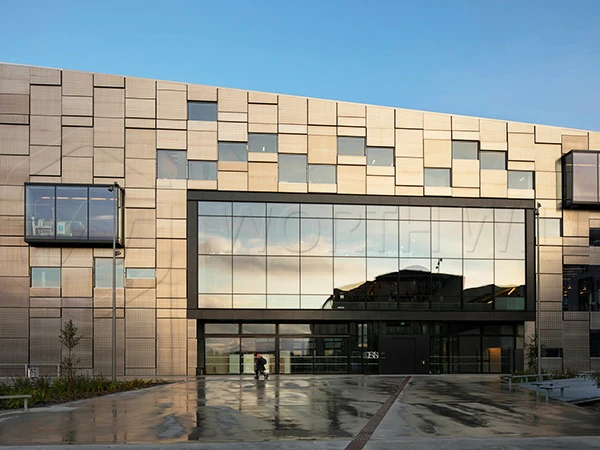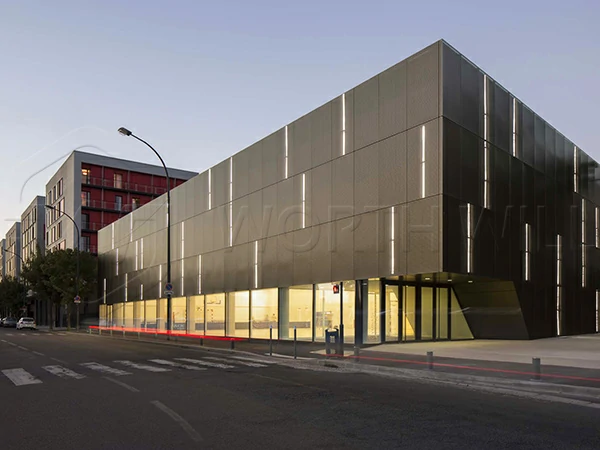Exterior Wall Cladding
- Home
- Exterior Wall Cladding
Exterior wall cladding is a crucial component of building design. It provides both functional and aesthetic benefits. It serves as the protective outer layer of a structure, shielding it from various environmental elements while enhancing its visual appeal.


Applications
Exterior wall cladding finds applications in various building types, including:
Residential Buildings: Commonly used in homes, adding curb appeal, insulation, and protection from the elements. It can transform the look of a house and improve energy efficiency.
Commercial Buildings: Office buildings, retail spaces, and hotels use cladding to create a professional and inviting appearance, as well as to enhance insulation and reduce maintenance costs.
Educational and Healthcare Facilities: Schools, universities, and hospitals benefit from cladding’s ability to provide a clean and durable exterior while ensuring energy efficiency.
Industrial Facilities: Factories and warehouses often employ cladding to protect the structure from harsh conditions and maintain a controlled interior environment.
The use of exterior wall cladding offers several significant advantages:
Weather Protection: Cladding acts as a barrier against weather-related damage, including rain, wind, and temperature fluctuations. This protection helps extend the lifespan of the building's structure.
Insulation: Many cladding materials are excellent insulators, improving a building's energy efficiency by reducing heat loss and gain. This leads to lower energy consumption and reduced utility costs.
Aesthetics: Cladding materials come in a wide variety of colors, textures, and designs. Allowing for customization and enhancing the building’s visual appeal.
Maintenance and Durability: Quality cladding materials are low-maintenance and highly durable, reducing the need for frequent repairs and upkeep.
Environmental Benefits: Sustainable cladding materials, such as recycled metal or engineered wood, contribute to environmentally friendly construction practices. These materials are often recyclable or have a longer lifespan.
Fire Resistance: Designed to be fire-resistant. Then improve safety in areas prone to wildfires or fire hazards.


Best Exterior Wall Cladding Options
The best exterior wall cladding option depends on various factors, including the specific requirements of your project, budget, and aesthetics. However, some of the most popular and effective cladding materials are:
Fiber Cement: Fiber cement cladding is a durable and versatile option known for its resistance to moisture, insects, and fire. It can mimic the appearance of wood, brick, or stone, offering a wide range of design possibilities.
Natural Stone: Stone cladding provides a timeless and elegant look. It’s ideal for creating a rustic or contemporary facade but can be costly and requires professional installation.
Wood: Wooden cladding adds warmth and character to a building’s exterior. Cedar, redwood, and thermally modified wood are popular choices due to their natural beauty and durability.
Metal: Metal cladding, including aluminum, zinc, and copper, offers a modern and industrial aesthetic. It is low-maintenance, durable, and often recyclable.
Vinyl: Vinyl cladding is an economical and low-maintenance option, available in various colors and textures. It’s particularly popular for residential buildings.
Brick: Brick cladding provides a classic, timeless appearance. It’s durable, fire-resistant, and requires minimal maintenance.
Composite Panels: Composite cladding combines different materials, such as metal and insulation. To offer both aesthetic and performance benefits. They are highly customizable and energy-efficient.
What is exterior wall cladding?
In conclusion, exterior wall cladding plays a pivotal role in protecting and enhancing the appearance of buildings.
The best cladding material for your project will depend on your specific needs, budget, and design preferences.
Careful consideration of these factors will help you choose the most suitable option for your construction project. It ensures a durable, efficient, and visually appealing exterior.
